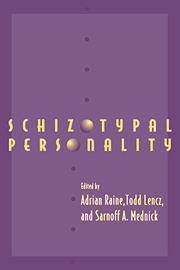Book contents
- Frontmatter
- Contents
- List of contributors
- Preface
- Acknowledgments
- Part I Introduction
- Part II Genetics and neurodevelopment
- 2 Family–genetic research and schizotypal personality
- 3 Schizotypal personality disorder characteristics associated with second-trimester disturbance of neural development
- 4 Neurodevelopmental processes in schizophrenia and schizotypal personality disorder
- Part III Assessment
- Part IV Categorical versus dimensional approaches
- Part V Psychophysiology and psychopharmacology
- Part VI Neuropsychology
- Part VII Brain imaging
- Part VIII Conclusion
- Part IX Appendix
- Name Index
- Subject Index
4 - Neurodevelopmental processes in schizophrenia and schizotypal personality disorder
from Part II - Genetics and neurodevelopment
Published online by Cambridge University Press: 04 August 2010
- Frontmatter
- Contents
- List of contributors
- Preface
- Acknowledgments
- Part I Introduction
- Part II Genetics and neurodevelopment
- 2 Family–genetic research and schizotypal personality
- 3 Schizotypal personality disorder characteristics associated with second-trimester disturbance of neural development
- 4 Neurodevelopmental processes in schizophrenia and schizotypal personality disorder
- Part III Assessment
- Part IV Categorical versus dimensional approaches
- Part V Psychophysiology and psychopharmacology
- Part VI Neuropsychology
- Part VII Brain imaging
- Part VIII Conclusion
- Part IX Appendix
- Name Index
- Subject Index
Summary
As defined by contemporary diagnostic criteria (DSM-III-R), schizotypal personality disorder (SPD) does not necessarily involve either subjective distress or impairment in occupational/academic functioning. Thus, in contrast to most other psychiatric disorders, the significance of SPD does not primarily lie in its negative consequences for the patient or society. Instead, its importance is due to its presumed association with more severe psychopathology – specifically, schizophrenia.
One prevalent notion, which receives tentative support from the research literature, is that some cases of SPD reflect a partially expressed genotype for schizophrenia (Clementz, Grove, Katsanis, & Iacono, 1991; Kendler, Ochs, Gorman, Hewitt, Ross, & Mirsky, 1991; Meehl, 1989, 1990; Schultz et al., 1986). This assumption raises the questions that are the primary focus of this chapter; namely, what neuropathological process might SPD and schizophrenia share in common, and what triggering mechanism(s) might be responsible for determining whether this constitutional vulnerability is behaviorally expressed in the clinical syndrome of schizophrenia versus SPD? We generate some hypothetical answers to these questions by drawing upon research findings on the developmental course of schizophrenia, as well as on theoretical models of the neuropathology underlying the disorder. Specifically, we explore the manner in which neurodevelopmental processes might interact with exogenous stressors in determining the extent of the behavioral expression of the diathesis.
The link between SPD and schizophrenia
As defined by contemporary diagnostic criteria, the “negative” symptoms of social withdrawal and constricted affect are a prominent feature of the SPD syndrome, and the boundaries are broad for these symptoms, in that they can vary in severity from mild to severe.
Keywords
- Type
- Chapter
- Information
- Schizotypal Personality , pp. 56 - 76Publisher: Cambridge University PressPrint publication year: 1995
- 2
- Cited by



